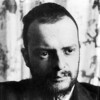Who was Paul Klee?
Paul Klee (1879-1940) was a Swiss-German painter, printmaker, and draughtsman who played a significant role in the development of modern art.
Klee was born in Münchenbuchsee, Switzerland, and trained at the Academy of Fine Arts in Munich, Germany. He was influenced by Expressionism, Cubism, and Surrealism, among other movements, but developed a style all his own. He was fascinated by color theory and often used abstract shapes and forms in his work.
Early years
Paul Klee was born on December 18, 1879, in Münchenbuchsee, a suburb of Bern, Switzerland. His father, Hans Klee, was a music teacher, and his mother, Ida Klee, was a singer. Klee was the second of two children in the family.
Klee showed an early aptitude for music and began playing the violin at the age of seven. He also showed an interest in drawing and painting, and his parents encouraged his artistic talents. In 1898, Klee began studying art at the Academy of Fine Arts in Munich, Germany.
Klee's time at the academy was difficult, and he struggled to find his own artistic voice. He was influenced by the prevailing academic style of the time, which emphasized realistic, representational art. Klee found this approach stifling and began to explore more experimental styles.
In 1905, Klee visited Paris, where he was exposed to the work of the Fauvists and the Cubists. These artists had a profound impact on Klee, and he began to experiment with their techniques and styles in his own work.
After completing his studies in Munich in 1906, Klee returned to Bern and began to establish himself as an artist. He continued to explore new styles and techniques, and his work began to gain recognition. In 1911, Klee met the artist Wassily Kandinsky, who would become a close friend and influence on his work.
Paul Klee, Angelus Novus, 1920. Watercolor, 31.8 × 24.2 cm. Jerusalem: Israel Museum.
Artistic training
Paul Klee's artistic training began in 1898, when he enrolled at the Academy of Fine Arts in Munich, Germany. There, he studied under a number of prominent artists, including Franz von Stuck and Heinrich Knirr.
After completing his studies in Munich in 1906, Klee returned to his hometown of Bern, Switzerland, and continued to develop his artistic skills. He spent a great deal of time drawing and sketching, honing his ability to capture the essence of a subject with a few deft strokes.
What was the first phase of Paul Klee's artistic career?
During this period, which lasted from around 1905 to 1914, Klee experimented with a wide range of approaches, from traditional academic drawing to Fauvism, Cubism, and Expressionism.
Klee's early work was often representational, featuring landscapes, portraits, and still lifes rendered in a realistic style. However, even in these early works, Klee showed a willingness to experiment with color and form, using bold hues and simplified shapes to create expressive effects.
As Klee's career progressed, his work became more abstract and symbolic. He began to incorporate geometric shapes, numbers, and other abstract elements into his paintings, as well as incorporating elements of folk art and non-Western art.
During this phase of his career, Klee's work was often inspired by his interest in music and poetry, as well as his fascination with color theory and the properties of light. His paintings often featured complex, layered compositions that invited viewers to explore multiple layers of meaning.
Klee's early works were not widely recognized or appreciated at the time, but they laid the foundation for the innovative and influential work that he would create later in his career.
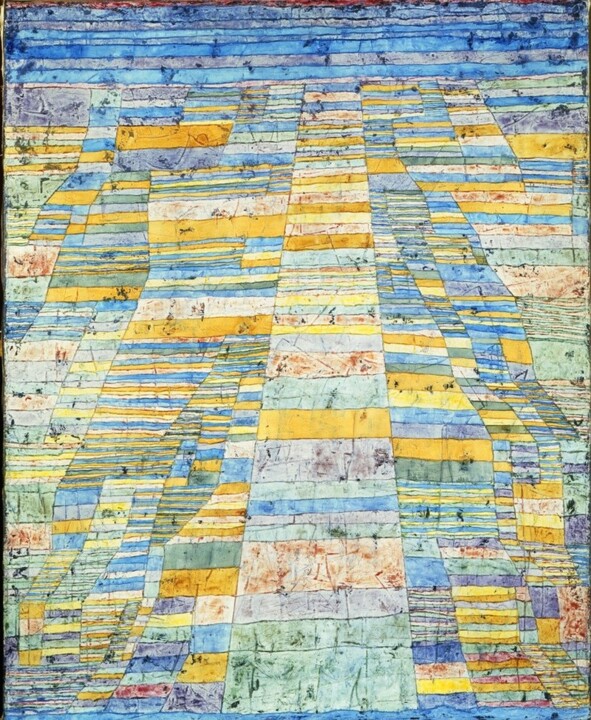 Paul Klee, Highway and Byways, 1920. Oil on canvas, 83.7 × 67.5 cm. Cologne: Museum Ludwig.
Paul Klee, Highway and Byways, 1920. Oil on canvas, 83.7 × 67.5 cm. Cologne: Museum Ludwig.
The affiliation to the "Blaue Reiter"
Paul Klee was a founding member of the Blaue Reiter (Blue Rider) group, which was established in Munich in 1911. The group was made up of a diverse range of artists, including Wassily Kandinsky, Franz Marc, August Macke, and Gabriele Münter, among others. They were united by their interest in abstract art and their desire to create a new, spiritual form of art that would transcend the limitations of the traditional, representational style.
Klee's affiliation with the Blaue Reiter had a profound influence on his artistic development. He was exposed to a range of new ideas and techniques, and his work began to move away from traditional representational art towards a more abstract, symbolic style.
One of the key principles of the Blaue Reiter was the belief in the spiritual and mystical power of art. Klee embraced this idea, and his work often incorporated elements of spirituality and mysticism. He was also influenced by the group's interest in non-Western art and culture, and he incorporated elements of Eastern art into his own work.
Klee's affiliation with the Blaue Reiter lasted until the outbreak of World War I, when the group disbanded. However, the ideas and principles that he absorbed during his time with the group continued to influence his work throughout his career.
Tunisia
In 1914, Paul Klee traveled to Tunisia with his friend, the artist August Macke. The trip had a profound influence on Klee's work, and he produced a number of important paintings and drawings based on his experiences there.
Klee was struck by the vibrant colors and geometric forms that he saw in Tunisia, and he began to experiment with these elements in his own work. He also drew inspiration from the patterns and motifs that he observed in Tunisian textiles and other decorative arts.
One of the most significant works that Klee produced as a result of his trip to Tunisia was a painting called "In the Style of Kairouan." The painting features a complex, abstract composition of geometric shapes and lines, rendered in a bold palette of reds, blues, and yellows. The work is widely regarded as a masterpiece of abstract art, and it has been described as a "visual poem" that captures the essence of Klee's experience in Tunisia.
 Paul Klee, Mask of fear, 1932. Oil on burlap, 100.4 x 57.1 cm. New York: MOMA.
Paul Klee, Mask of fear, 1932. Oil on burlap, 100.4 x 57.1 cm. New York: MOMA.
Did Paul Klee have a military career?
Paul Klee had a brief military career. In 1916, during World War I, Klee was drafted into the German army and assigned to a unit that was responsible for constructing defenses along the Swiss border. Klee's artistic skills were put to use in this role, as he was tasked with creating maps and diagrams of the terrain and fortifications.
Klee's military service was difficult for him, as he was a pacifist at heart and did not believe in the war. He suffered from health problems and anxiety, and he was eventually discharged from the army in 1918 on medical grounds.
Despite the challenges of his military service, Klee continued to produce art during this period, and he even found inspiration in some of the materials and tools that he encountered while serving in the army. For example, he used military graph paper and drafting tools in some of his drawings and paintings from this period.
Klee's military service was relatively brief, and it did not have a significant impact on his artistic career in the long run. However, it is an important part of his personal history, and it sheds light on the challenges that he faced during a tumultuous period in European history.
The mature period
The mature period of Paul Klee's artistic career began in the 1920s and continued until his death in 1940.
In the early 1920s, Klee began to experiment with a new style that was characterized by a more complex and abstract use of color and form. He also continued to explore themes of spirituality and mysticism, drawing inspiration from a wide range of sources, including Eastern philosophy, mythology, and music.
One of the key elements of Klee's mature style was his use of color. He developed a unique approach to color theory that emphasized the relationships between colors and the emotions and sensations that they evoke. He also experimented with a wide range of materials and techniques, including oil paint, watercolor, and pastel, as well as collage and mixed media.
Throughout his mature period, Klee continued to draw inspiration from his travels and personal experiences, as well as from his interest in music and the natural world. His works often feature complex, symbolic compositions that invite the viewer to explore a range of associations and meanings.
 Paul Klee, A young lady's adventure, 1921. Watercolor on paper, 43,8 x 40,8 cm. London: Tate Modern.
Paul Klee, A young lady's adventure, 1921. Watercolor on paper, 43,8 x 40,8 cm. London: Tate Modern.
The Bauhaus
Paul Klee was an important member of the Bauhaus, a revolutionary art school that was founded in Germany in 1919. Klee joined the school as a faculty member in 1920, and he taught there until 1931.
At the Bauhaus, Klee played a key role in developing the school's curriculum and pedagogy. He believed that art and design should be taught as a form of visual literacy, and he encouraged his students to explore the relationships between color, form, and texture in their work.
Klee also developed a number of innovative teaching techniques, including exercises in which students would create abstract compositions based on musical themes or natural phenomena. He believed that these exercises could help students develop their creativity and expand their understanding of the visual arts.
Klee's own work during his time at the Bauhaus was highly experimental and diverse. He continued to explore abstract forms and color relationships in his paintings and drawings, and he also created a number of three-dimensional works, including sculptures and constructions.
The death
Paul Klee died on June 29, 1940, at the age of 60. He had been suffering from a progressive disease for several years, and his health had been declining rapidly in the months leading up to his death.
Klee's death came at a difficult time in history. He had been living in Switzerland since the 1930s, but his status as a German citizen and his Jewish heritage made him a target of Nazi persecution. His works had been labeled as "degenerate art" by the Nazi regime, and many of them had been removed from German museums and galleries.
Despite the challenges that he faced in his final years, Klee continued to create art until the end of his life. His last works were a series of small watercolors that he created in the months before his death. These works are characterized by a sense of introspection and reflection, and they are often seen as a reflection of Klee's own mortality.
 Paul Klee, Cosmic Composition, 1919. Oil on pasteboard, 48 x 41 cm. Düsseldorf: Kunstsammlung Nordrhein-Westfalen.
Paul Klee, Cosmic Composition, 1919. Oil on pasteboard, 48 x 41 cm. Düsseldorf: Kunstsammlung Nordrhein-Westfalen.
Style and methods
Paul Klee's style and methods were characterized by a unique combination of abstraction, symbolism, and experimentation. Throughout his career, Klee was constantly exploring new techniques and approaches to art, and his works are marked by a sense of playfulness, curiosity, and innovation.
One of Klee's most distinctive stylistic features was his use of color. He developed a unique approach to color theory that emphasized the relationships between colors and the emotions and sensations that they evoke. He believed that colors could be used to express a wide range of emotions and moods, and he often used them to create a sense of depth and movement in his compositions.
Klee also had a deep interest in symbolism and mythology, and many of his works incorporate abstract forms and motifs that are inspired by ancient cultures and spiritual traditions. He believed that art could be used to express universal human experiences and emotions, and he often used symbolism as a way to explore these themes.
In terms of his methods, Klee was a highly experimental artist who worked with a wide range of materials and techniques. He was particularly interested in the possibilities of watercolor and other transparent media, which allowed him to create subtle gradations of color and texture. He also experimented with collage and mixed media, and he created a number of three-dimensional works, including sculptures and constructions.
What are Paul Klee's most famous artworks?
- "Senecio" (1922): This painting is also known as "Head of a Man" and is one of Klee's most recognizable works. It features a face made up of brightly colored geometric shapes.
- Twittering Machine (1922): This whimsical work depicts a strange mechanical device with a bird-like appearance. The machine is made up of intricate geometric forms and is set against a vibrant blue background.
- Ad Parnassum (1932): This abstract work is named after the ancient Greek mountain of Parnassus, which was believed to be the home of the muses. The composition features a series of intricate geometric forms and delicate color washes, which combine to create a sense of harmony and balance.
- The Golden Fish (1925): This colorful work features a fish-like creature composed of a series of intricate patterns and shapes. The work is highly detailed and features a playful sense of humor, which is characteristic of much of Klee's art.
- Insula dulcamara (1938): This abstract work features a series of overlapping forms and shapes, which combine to create a sense of depth and movement. The work is highly abstract and reflective of Klee's interest in the underlying structures and patterns of the natural world.
 Paul Klee, Twittering Machine, 1922. Watercolor and ink; oil transfer on paper with gouache and ink on border, 63.8 × 48.1 cm. New York City: Museum of Modern Art.
Paul Klee, Twittering Machine, 1922. Watercolor and ink; oil transfer on paper with gouache and ink on border, 63.8 × 48.1 cm. New York City: Museum of Modern Art.
Focus on Twittering Machine (1922)
"Twittering Machine" is a famous painting created by Paul Klee in 1922. It depicts a strange, bird-like machine composed of intricate geometric shapes and patterns. The machine is perched on spindly legs and appears to be tweeting like a bird, hence the title of the painting.
The background of the painting is a vibrant blue color, which contrasts with the muted tones of the machine. The machine itself is highly detailed and features a range of intricate shapes and patterns, which combine to create a sense of movement and energy.
"Twittering Machine" is often seen as a commentary on the dehumanizing effects of modern technology. Klee was interested in the relationship between man and machine, and he believed that technology could lead to a loss of individuality and a sense of isolation. The painting is highly abstract and open to interpretation, and it remains one of Klee's most famous and iconic artworks.
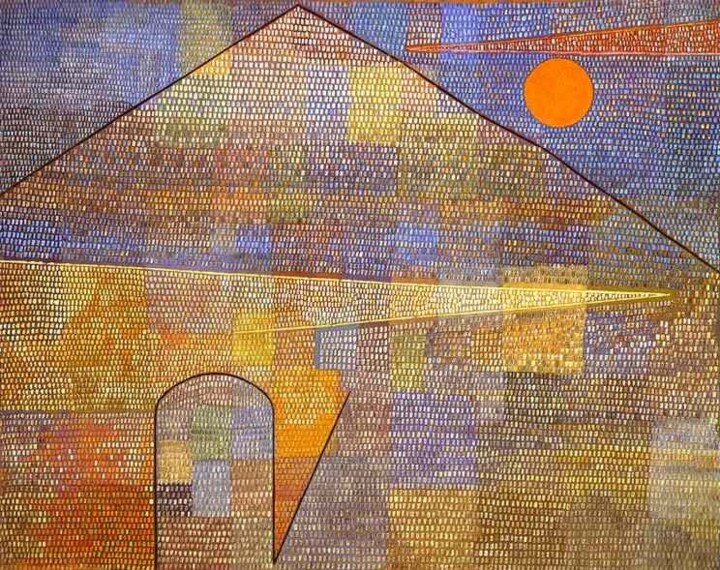 Paul Klee, Ad Parnassum, 1932. Oil on canvas, 100 x 128 cm. Berna: Kunstmuseum.
Paul Klee, Ad Parnassum, 1932. Oil on canvas, 100 x 128 cm. Berna: Kunstmuseum.
Focus on Ad Parnassum (1932)
"Ad Parnassum" is a famous painting created by Paul Klee in 1932. The title of the painting is a reference to Mount Parnassus in Greece, which was believed to be the home of the muses in Greek mythology.
The painting is highly abstract and features a series of intricate geometric forms and delicate color washes. The composition is divided into several sections, each of which features a different arrangement of shapes and colors.
The overall effect of the painting is one of harmony and balance, with the various forms and colors combining to create a sense of unity and coherence. The use of delicate color washes and soft, muted tones is characteristic of Klee's work, and it gives the painting a dreamlike, ethereal quality.
"Ad Parnassum" is often seen as a reflection of Klee's interest in music and the principles of harmony and rhythm. The painting has been interpreted in many different ways, and it remains one of Klee's most famous and enduring artworks.
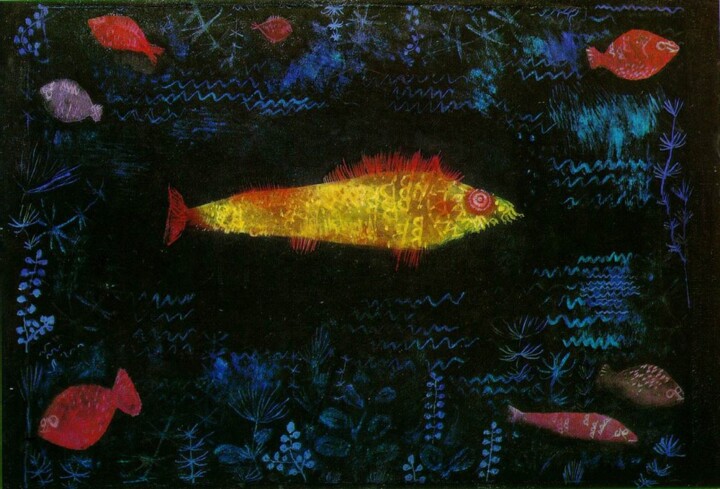 Paul Klee, The Goldfish, 1925. Oil and watercolor on paper mounted on cardboard. Hamburg: Hamburger Kunsthalle.
Paul Klee, The Goldfish, 1925. Oil and watercolor on paper mounted on cardboard. Hamburg: Hamburger Kunsthalle.
Focus on The Golden Fish (1925)
"The Golden Fish" is a painting by Paul Klee that was created in 1925. It is an abstract work that features a series of geometric forms and bright, contrasting colors. The painting depicts a stylized fish that is composed of a series of angular, abstract shapes. The fish is rendered in shades of yellow and orange.
One of the most striking features of "The Golden Fish" is its use of color. Klee was known for his innovative approach to color theory, and this painting is a great example of his use of bright, contrasting hues to create a sense of depth and movement. The warm tones of the fish contrast with the cool tones of the background, creating a dynamic interplay of color and form.
In addition to its bold use of color, "The Golden Fish" is also notable for its abstract, geometric forms. Klee was deeply interested in the possibilities of abstraction, and he often used simple shapes and lines to create complex, layered compositions.
 Paul Klee, Insula dulcamara, 1938. Oil on newsprint on burlap, 88 x 176 cm. Berne: Zentrum.
Paul Klee, Insula dulcamara, 1938. Oil on newsprint on burlap, 88 x 176 cm. Berne: Zentrum.
Focus on Insula dulcamara (1938)
"Insula dulcamara" is a painting by Paul Klee that was created in 1938, just a few years before his death. It is an abstract work that features a series of intricate lines and forms, rendered in muted tones.
The title "Insula dulcamara" refers to a plant known as bittersweet nightshade, which is poisonous but also has medicinal properties. This theme of duality and contradiction is reflected in the painting's abstract forms, which suggest both organic and mechanical elements.
The painting is divided into a series of rectangular and triangular shapes, which are interconnected by a network of delicate, swirling lines. These lines create a sense of movement and flow, while also adding a sense of depth and complexity to the composition.
Like many of Klee's works, "Insula dulcamara" is highly symbolic, and it invites the viewer to interpret its meaning in a personal way. Some have suggested that the painting is a commentary on the political turmoil of the time, while others see it as a reflection of Klee's own personal struggles with illness and mortality.
Some anecdotes about Paul Klee
- Klee created over 10,000 artworks of art during his career. He often worked in a small format, producing intricate and detailed drawings and watercolors that were highly prized by collectors.
- Klee was a talented musician as well as an artist, and he often used musical themes and motifs in his artwork. He believed that music and art were closely related, and that the principles of harmony and rhythm could be applied to both.
- Klee was fascinated by the occult and mystical, and he was a member of a group called "The Blue Rider," which was dedicated to exploring spiritual and mystical themes in art. Klee's interest in the occult is reflected in many of his artworks, which often feature abstract and symbolic imagery.
- Klee suffered from a rare autoimmune disease called scleroderma, which caused the hardening of his skin and other tissues. Despite his illness, Klee continued to work and create art until his death in 1940 at the age of 60.
Famous quotes about Paul Klee
- "Paul Klee is a great artist. His delicate color nuances, his refined lines, and his masterful compositions reveal a truly unique talent." - Wassily Kandinsky
- "Paul Klee's art is like the art of a child, only better." - Pablo Picasso
- "Klee's paintings are like visual music." - Henri Matisse
- "Klee's paintings are like visual music." - Henri Matisse



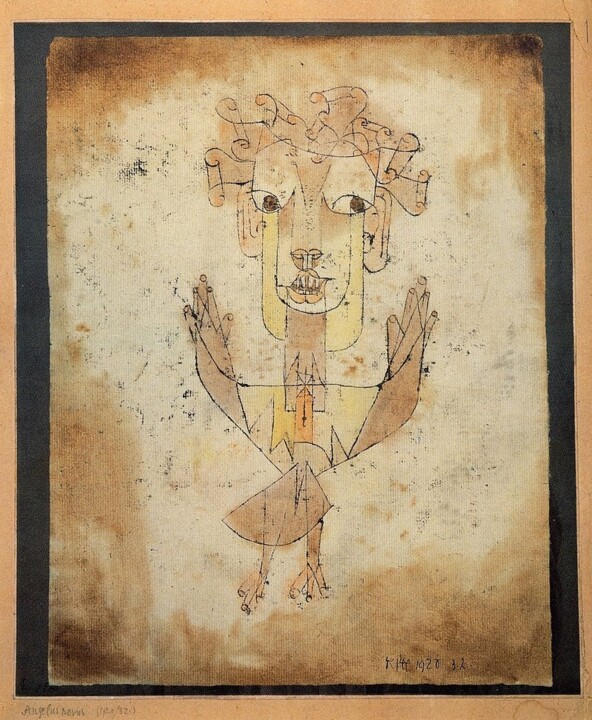
 Jean Dubreil
Jean Dubreil
